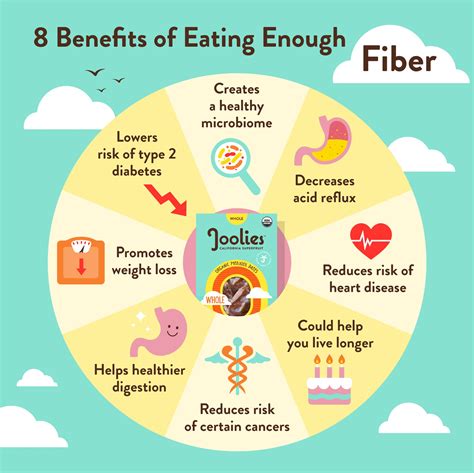Intro
Discover the best foods high in fiber, including fruits, veggies, and whole grains, to boost digestive health and support healthy gut bacteria with soluble and insoluble fiber rich foods.
Fiber is an essential nutrient that plays a critical role in maintaining a healthy digestive system, promoting satiety, and supporting healthy blood sugar levels. Despite its importance, many people do not consume enough fiber in their diets. The daily recommended intake of fiber is 25-30 grams per day, but the average person consumes only about 15 grams per day. Increasing fiber intake can have numerous health benefits, including promoting regular bowel movements, preventing constipation, and supporting healthy gut bacteria. In this article, we will explore the best foods high in fiber, their benefits, and how to incorporate them into your diet.
A high-fiber diet can have a significant impact on overall health and well-being. Fiber helps to slow down the digestion of food, which can help to regulate blood sugar levels and promote feelings of fullness. This can be particularly beneficial for people with diabetes or those who are trying to lose weight. Additionally, a high-fiber diet has been shown to lower cholesterol levels, reduce inflammation, and even support healthy blood pressure levels. With so many benefits, it's no wonder that healthcare professionals and nutritionists recommend increasing fiber intake.
Incorporating high-fiber foods into your diet can be easy and delicious. From fruits and vegetables to whole grains and legumes, there are many tasty and nutritious options to choose from. Some of the best foods high in fiber include avocados, berries, and leafy greens like spinach and kale. These foods are not only high in fiber but also rich in other essential nutrients like vitamins, minerals, and antioxidants. By making a few simple changes to your diet, you can increase your fiber intake and start experiencing the many benefits of a high-fiber diet.
Benefits of High-Fiber Foods

Types of Fiber
There are two main types of fiber: soluble and insoluble. Soluble fiber dissolves in water and forms a gel-like substance in the digestive system, which can help to slow down digestion and regulate blood sugar levels. Insoluble fiber, on the other hand, does not dissolve in water and helps to add bulk to stool, promoting regular bowel movements. Both types of fiber are essential for maintaining a healthy digestive system and promoting overall health.High-Fiber Fruits

High-Fiber Vegetables
Vegetables are another excellent source of fiber. Some of the best high-fiber vegetables include: * Broccoli: 1 cup of cooked broccoli contains 5 grams of fiber * Carrots: 1 cup of cooked carrots contains 3 grams of fiber * Brussels sprouts: 1 cup of cooked Brussels sprouts contains 5 grams of fiber * Sweet potatoes: 1 medium sweet potato contains 4 grams of fiber * Artichokes: 1 medium artichoke contains 7 grams of fiberHigh-Fiber Grains

High-Fiber Legumes
Legumes are a type of plant-based protein that is high in fiber and other essential nutrients. Some of the best high-fiber legumes include: * Lentils: 1 cup of cooked lentils contains 16 grams of fiber * Chickpeas: 1 cup of cooked chickpeas contains 12 grams of fiber * Black beans: 1 cup of cooked black beans contains 9 grams of fiber * Kidney beans: 1 cup of cooked kidney beans contains 8 grams of fiber * Soybeans: 1 cup of cooked soybeans contains 10 grams of fiberIncreasing Fiber Intake

Common Mistakes to Avoid
When increasing fiber intake, there are some common mistakes to avoid. These include: * Increasing fiber intake too quickly, which can cause digestive discomfort * Not drinking enough water, which can cause constipation * Not incorporating a variety of high-fiber foods into your diet * Relying on supplements instead of whole foods * Not being patient, as it can take time to see the benefits of a high-fiber dietConclusion and Next Steps

We invite you to share your thoughts and experiences with high-fiber foods in the comments below. What are your favorite high-fiber foods? How have you incorporated them into your diet? Share your tips and advice with others and help to create a community of like-minded individuals who are passionate about healthy eating.
What is the daily recommended intake of fiber?
+The daily recommended intake of fiber is 25-30 grams per day.
What are the benefits of a high-fiber diet?
+A high-fiber diet can help to promote regular bowel movements, support healthy blood sugar levels, and lower cholesterol levels.
What are some high-fiber foods that I can incorporate into my diet?
+Some high-fiber foods include avocados, berries, leafy greens, whole grains, and legumes.
How can I increase my fiber intake gradually?
+You can increase your fiber intake gradually by starting your day with a high-fiber breakfast, snacking on fruits and vegetables, and incorporating legumes into your meals.
What are some common mistakes to avoid when increasing fiber intake?
+Some common mistakes to avoid include increasing fiber intake too quickly, not drinking enough water, and not incorporating a variety of high-fiber foods into your diet.
